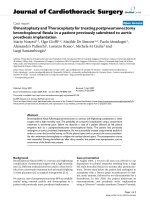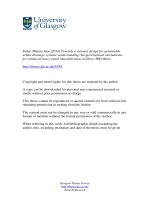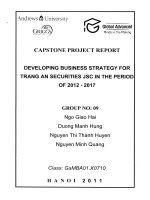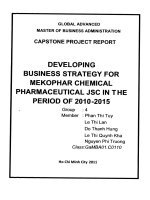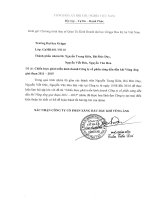Using neem seeds for treating drosophila suzukii matzumura in growing rubus idaeus in oberkirch german
Bạn đang xem bản rút gọn của tài liệu. Xem và tải ngay bản đầy đủ của tài liệu tại đây (1.11 MB, 40 trang )
THAI NGUYEN UNIVERSITY
UNIVERSITY OF AGRICULTURAL AND FORESTRY
TRAN THI THAO NGUYEN
USING NEEM SEEDS FOR TREATING DROSOPHILA SUZUKII
MATZUMURA IN GROWING RUBUS IDAEUS
IN OBERKIRCH - GERMANY
BACHELOR THESIS
Study Mode: Full-time
Major:
Environmental Science and Management
Faculty:
International Programs Office
Batch:
K46-N01
Type:
On-the-Job Training (OJT)
Thai Nguyen, 25/09/2019
DOCUMENTATION PAGE WITH ABSTRACT
Thai Nguyen University of Agriculture and Forestry
Degree Program
Bachelor of Environmental Science and Management
Student name
Tran Thi Thao Nguyen
Student ID
DTN 1454290061
Using Neem Seeds for treating Drosophila Suzukii
Thesis Title
matzumura in growing Rubus idaeus in OberkirchGermany
Supervisor (s)
Dr. Hoang Thanh Hai
Supervisor’s Signature
Abstract:
Chemical pesticides are causing adverse environmental impacts that threaten the
development of organisms and human health. Biological solutions have been
being studied and applied to minimize this situation. The aim of this study is to
rasreraspberries
find information about the constitution, the consequences of neem seeds on the
development and reproductive of Drosophila suzukii matzumura, how to use this
bio-pesticide effectively to protect berry farms in Germany and valuate why this
solution should be used to treating insects in the long run.
Neem oil, Azadirachta indica, raspberry (Rubus idaeus),
Keywords:
Drosophila suzukii matzumura (Spotted Wing Drosophila)
Number of pages:
39
Date of Submission:
25/09/2019
ii
ACKNOWLEDGEMENT
Spending six months working and studying in a berry farm in Oberkirch,
Germany, I have acquired lots of knowledge about using high - technology and
using biological methods to take care of plants, which reinforces knowledge
about the importance of protecting the environment.
In order to complete a successful internship, I would love to express my
gratefulness to Mrs. Susanne for her kind support and caring went through the
time I took my internship.
There are no words to show my appreciation to my supervisor Dr. Hoang
Hai Thanh for her useful comments, remarks and support me to complete the
thesis. I would also like to thank the ITC center for their assistance and caring.
Last but not least, I wish to express my gratitude to my parents for their
love, care and motivation throughout my whole life.
Thai Nguyen, September 2019
Tran Thi Thao Nguyen
iii
TABLE OF CONTENT
List of Tables .......................................................................................................... 1
List of Figures ......................................................................................................... 2
CHAPTER I. INTRODUCTION ........................................................................ 3
1.1. Rationale .......................................................................................................... 3
1.2. Objectives ........................................................................................................ 4
1.3. Contents of work ............................................................................................. 4
1.4. Profile of the cooperating agency .................................................................... 4
1.5. Description of my activities............................................................................. 5
1.6. Timeline ........................................................................................................... 6
CHAPTER II. LITERATURE REVIEW .......................................................... 7
2.1. Theoretical basis .............................................................................................. 7
2.1.1. The valuation of Neem ................................................................................. 7
2.1.2. Introduction to raspberries .......................................................................... 14
2.1.3. Introduction to fruit fly (Drosophila suzukii matzumura) .......................... 17
2.1.4. The effect of Drosophila suzukii on raspberries ........................................ 20
2.2.1. Neem research in the world ........................................................................ 21
2.2.2. Neem research in Vietnam ......................................................................... 22
CHAPTER III. STATUS OF THE CONSIDERED ISSUE AT THE
TRAINING AGENCY ....................................................................................... 23
3.1. Object and scope of the study ........................................................................ 23
3.1.1. Object of study ........................................................................................... 23
3.1.2. Scope of the study ...................................................................................... 23
iv
3.2. Location and time conduct ............................................................................ 23
3.2.1. Location ...................................................................................................... 23
3.2.2. Time ............................................................................................................ 23
3.3. Research contents .......................................................................................... 23
3.4. Method ........................................................................................................... 23
3.4.1. Method of collecting secondary information ............................................. 23
3.4.2. Observation method.................................................................................... 24
3.5. Introduction to the berries garden at 81 Herztal, Oberkirch.......................... 24
3.5.1. Introduction to red raspberries.................................................................... 24
CHAPTER IV. DISCUSSION AND LESSON LEARNDED ......................... 29
4.1. Discussion ...................................................................................................... 29
4.2. Lesson learned ............................................................................................... 29
CHAPTER V. CONCLUSION.......................................................................... 30
REFERENCES ................................................................................................... 31
v
LIST OF TABLES
Table 1.1. Construction of work ............................................................................. 5
Table 2.1. Specifications for neem kernel oil ......................................................... 8
Table 2.2. Requirements of neem cake for manuring ............................................ 9
Table 2.3. United States and European raspberry production .............................. 16
Table 3.1: Nutritional content of red raspberries (100g) ...................................... 25
1
LIST OF PICTURES
Picture 2.1: Spotted wing drosophila.................................................................... 18
Picture 2.2: SWD life cycle .................................................................................. 19
Picture 2.3: The female lays eggs ......................................................................... 20
Picture 3.1: Some types of berries in the garden .................................................. 24
Picture 3.2: Neem seed oil spraying ..................................................................... 28
2
CHAPTER I. INTRODUCTION
1.1. Rationale
To deal with pests and diseases and protect production, Vietnamese farmers
still rely heavily on chemical use. This measure not only directly affects
producers and agricultural environment but also causes great difficulties for
monitoring residues in agricultural products. The limitation of chemical drugs in
plant protection is high toxicity, long isolation time, so it is difficult to comply
with the isolation time. Meanwhile, the control of chemical residues in
agricultural products is very difficult because we now have many active
ingredients in pesticides put into use. Moreover, if managing drug residues
through checking agricultural products, the cost of analysis is very high, not
feasible when deployed on a large scale.
Pesticides and drug residues are always considered concerns about the
health of society and are related to a series of diseases and disorders in the human
body. The association between pesticides, growth stimulants and health problems
such as cancer, hyperactivity reduction and neurological disorders. Noticeably, if
exposed too much, it will weaken the immune system.
In Germany, many research activities of bio-pesticides appear to replace
chemical drugs for safe vegetable production. In the world, the application of biopesticides is considered an effective solution in Product Quality Management. In
order to strengthen the university-trained knowledge of the environment and expand
the knowledge of green technology, I chose the topic: Using Neem Seeds for
treating fruit flies in growing raspberries in Oberkirch- Germany.
3
1.2. Objectives
- Getting an overview and knowledge of the consequences of Neem seeds
on the growth and reproductive of fruit flies.
- Familiar with how to use this bio-pesticide effectively to protect berry farms
in Germany and valuate why this solution should be used to treating insects in the
long run.
1.3. Contents of work
- Find information, collect data related to raspberries, spotted wing
drosophila and weather condition in Oberkirch, Germany.
- Looking for information about Neem seeds.
- Attend meetings and work in the farm.
1.4. Profile of the cooperating agency
The OGM Obstgroßmarkt Mittelbaden eG - are a modern and highperformance producer cooperative with headquarters in Oberkirch in central Baden.
Fruit Producers deliver their daily freshly harvested products to the company. In
here, the fruits are checked thoroughly, the entire flow of goods is bundled, and
orders are immediately picked and loaded. The products include: Apples, pears,
plums, strawberries, blackberries, raspberries, currants, blueberries, gooseberries,
grapes, Mirabelle plums, cherries.
Susanne was my supervisor during my internship. She works in OGM
Market which is a fruit distribution company in Oberkirch. She works as a
Quality controller and lab manager in the company. She also own a small farm
for her experiment and I work in her farm during my internship. We meet up
every day to discuss about the growth of plants or problems occurring.
4
1.5. Description of my activities
Table 1.1. Construction of work
Time
Tasks
Described in detail
1st week
General introduction
Instruction in the company structures,
getting to know the company.
2-3 week
Products
Learning the different blackberry and
raspberry varieties and their climatic
requirements
(humidity,
temperature,
etc.,)
4-17 week
Cultural work
Perform quality control of the soil and
bromine and
young plants, analyze nutrients and
raspberries
determine PH-value, prepare soil with
compost and fertilizer, monitor and
document weather conditions, observe
growth
processes
changes,
determine
and
determine
planting
time,
arrange rows of perennials according to
given distance, weeds between crops,
remove perennials and work in mulch
and fertilizer, pay attention to water
supply, cut back foothills, identify plants
and
their
causes,
select
fertilizer
procedures and fertilizer appropriate and
5
environmentally friendly, carry out plant
protection measures as required and
environmentally sound, identify and
store
soils
equipment
recognize
as
required,
maintain
and
tools,
detection
the
production
profitability
process
of
and
the
tunnel
production.
18-26 week
Harvest, marketing,
sale
Careful assessment of the berry’s
maturity
according
coloration,
control,
to
performing
picking
performing
ready-to-sell
size
fruit-hanging
berries
quality
berries,
and
properly,
control,
storing
sorting
them,
packaging them according to product,
helping with sales and marketing,
shipping (labeling).
1.6. Timeline
6 months working in the Susanne’s farm from 16th April 2018 to 14th
October 2018.
6
CHAPTER II. LITERATURE REVIEW
2.1. Theoretical basis
2.1.1. The valuation of Neem
a. Neem Introduction
Neem, Azadirachta indica (𝐶35 𝐻44 𝑂16 ) are derived from arid areas of
Indian subcontinent, where it is as high as 12 - 24 m at altitude from 50 to 100 m
with 130 mm enough rainfall every year for its normal development. In India,
neem is mostly used in rice cultivation. Another name of neem is ‘arista, in
Sanskrit - a word means 'Perfect, complete and imperfect. Sanskrit name Nimba
radically derives from the term ‘nimbatisyasthyamdadatiát means ‘to give good
health. All parts of the plant accommodate compounds with proven antiseptic,
antiviral,
antipyretic,
anti-inflammatory,
anti-ulcer
and
antifungal
uses
(Subbalakshmi Lokanadhan et al. 2012). Azadirachta indica can be easily
propagated by seed or transplant 9 to 12-month-old neem seedlings.
Each year a neem tree can provide 37 to 50 kg fresh fruit. Dry 40 kg fresh
fruit nearly 24 kg of dry fruit (60%), these dried fruit gives 11.52 kg of pulp
(48%), 1.1 kg of seed coat (4.5%), 1 kg of husk (25%) and 5.5 kg of kernel
(23%) (Subbalakshmi Lokanadhan et al. 2012). The kernel provides about 2.5 kg
of neem oil (45%) and 3.0 kg neem cake (55%) (Subbalakshmi Lokanadhan et al.
2012). Nowadays, neem is recognized as an effective natural product to address
global issues in agriculture, environment and public health categories.
Neem plants include several thousands of chemical substances. In which, the
most active and well-studied compound is Azadirachtin. A mixture of neem
chemicals are existing and give operational principles although most of traditional
7
preparation of neem are pesticide or medicine. There are some types of
azadirachtins (A to K) have been separated, of which the richest are Azadirachtin.
Neem terpenoids exist in all parts of tree, in living tissue. Recently, the site
synthesized and the accumulation of chemicals in neem has been identified as
secretory cells. The seed kernels contain a large quantity of secretory cells. Iodine
solution can be used to identify secretory cells. In addition to terpenoids, there are
more than 20 sulfurous compounds in neem. These compounds are responsible for
typical smell of crushed seeds and neem oil (Table 2.1).
Table 2.1. Specifications for neem kernel oil
Characteristic
Maximum moisture and insoluble impurities
Requirement
0.3 % by weight
Lovibond colour (1/4 in cell), expressed as Y +
5R, not deeper than
45.0
Refractive index at 400C
1.4615 – 1.4705
Specific gravity
0.908 – 0.934
Saponification value
180-205
Iodine value (Wij’s method)
65-80
Maximum acid value
15
Maximum unsaponifiable matter
2% by weight
Minimum titre
36℃
Source: Indian Standards Institution specification 4765. The colour index
indicates the degree of deterioration of nonfatty constituents present in the seed
vis-à-vis quality of oil.
8
Table 2.2. Requirements of neem cake for manuring
Characteristic
Maximum moisture (% by mass)
Requirement
10.0
Minimum water-soluble organic N % 2.5
by mass on moisture-free basis
Maximum total ash % by mass
13.0
Maximum acid-insoluble ash (% by 5.0
mass) on moisture free basis
Source: Indian Standards Institution specification 8558
b. Neem application
- Neem used as Fertilizer
The seed cake is the material left after extract oil from seeds. It works as a
biological fertilizer and helps provide essential nutrients for plants. That is
widely used to ensure high productivity of plants. This kind of fertilizer is used
for food crops and cash crops, especially rice and sugarcane crops. It also inhibits
the development of pest and bacteria in the soil, offers vital nutrients for plants
growth, helps to boost the productivity of plants in the long term, biodegradable
and environmentally friendly and excellent soil conditioning.
- Neem used as Manure
Any animal or plant material utilized to fertilize land is manure, it improves
the soil fertility and promoting plant growth (Subbalakshmi Lokanadhan et al.
2012). Neem manure is increasing popular because it's friendly with environment
and also the substances found in it help increase nitrogen and phosphorus content
in the soil. It is very rich in sulfur, potassium, calcium, nitrogen, etc. Neem gear
9
is used to produce high standard organic or natural manure, in which there are no
consequences for plants, soil and other organisms. Some high technology
extraction methods such as cold pressing or other solvents are used to obtain
neem oil.
It can be utilized instantly by admix with soil or it can be mixed with urea
and other organic fertilizers such as farms manure and sea grass give the best
results. It can be biodegradable and environmentally friendly, nourishing soil and
plants by bring forth all macro and micro nutrients, help eliminate bacteria
responsible for denitrification soil, ideal for crops and food crops, increasing
productivity of plants, helps reduce fertilizer use, thus reducing cost of planting
trees, anti-freezing properties to lower the number and development of insects
and pests.
- Neem as urea coating agent
Neem are being utilized to make urea coating agent to appreciate and uphold
soil fertility. Fertility soil can be measured with nitrogen, potassium and phosphorus.
There are some bacteria found in soil, which deoxidizes it. Use neem urea coating
agent helps slow down the activity and growth of bacteria responsible for reducing
nitrate. It prevents loss of internal urea land. It can also be utilized to control a large
quantity of pests like caterpillars, beetles, hoppers, stem borers, and so on. Urea
coatings are usually available in liquid form or powder form. Properties of the Urea
Neem coating are Anti animal feed, anti-breeding and pest growth regulator. Neem
Urea coating is an excellent soil conditioner, natural or biological, environmentally
friendly, non-toxic pesticides, reduce urea expending, apply easily, high soil fertility
and increased crop productivity.
10
- Neem as soil conditioner
Neem seed granules or powdered seeds can be used to make soil
conditioner. It can be put in for sowing plants or can sprinkle and scratch the soil.
The sprinkling process must be following proper irrigation so that the product
can come to the roots. It is a natural soil regulation improves soil quality; from
there enhance the development of plants and fruits. Organic soil air conditioning
is becoming popular in the agricultural sector, in both Asian countries such as
India and in the west partners like USA, UK and Australia. Neem is a natural soil
conditioner that improves soil quality, thereby enhancing plant growth and fruit.
It not only helps plants develop but also obstruct them from the destruction of
some pests and insects. Regulating organic soil is becoming popular in high-tech
agriculture. They are not harmful, effective and cheaper than other land
conditioners. This natural soil conditioning is also multi-functional and in-side
tropical region. Application of neem soil conditioner in crops is noticed to be a
soil improvement aid increase its fertility.
- Neem as fumigant
Neem tree has been utilized to prevent many kind of pests. The gaseous
state of neem fumigant is used as a pesticide and disinfectant (Subbalakshmi
Lokanadhan et al. 2012) . A large number of people all over the world use neem
tree on a commercial basis. This 100% natural product is underway export
because it is non-toxic and it is totally environmentally friendly. It is said to be
more important in underdeveloped countries where millions of deaths are
reported annually by accident amount of synthetic pest disinfectant. Is this
natural disinfectant only kill pests but also negatively affect them by acting like
11
feeding and preventing ovulation, intermittent mating, inhibit growth, etc.
According to research undertaken, neem fumigant helps protect stored rice from
pests. One of the main benefits of this organic disinfectant is that pests cannot
grow well on it.
Because of using bio fertilizers, insecticides and pesticides in agriculture
are becoming more popular, neem is increasingly being harvested and planted all
around the world to take azadirachtin, liable for preventing the development
cycle of insects and pests, mushrooms etc. Neem is also taking on a lot of
importance in managing crop. It is undeniable the fact that neem is not just a
cheaper, natural products and an effective way to control pests and insects, but
also no harm plants or other organisms. It is true that many studies are being
made to test neem and its products for large scale production of organic
pesticides and insecticides. This is a great chances for producers and exporters to
make high quality biological agricultural products. Neem oil and is said to have
germicidal and anti-bacterial properties which is useful to protect plants from
different types of pests. There is no residue remain on plants after using this
organic product (Subbalakshmi Lokanadhan et al. 2012). Neem antiseptic is
environmentally friendly, not harmful to others microorganisms, non-toxic and
non-polluting terrestrial and underwater environments. Pests and diseases cannot
grow resistance to it, no negative after effects, is less expensive, has the function
of preventing pests and nourishing the soil like controlling pest reproduction.
- Neem as pesticide
Neem pesticide plays an essential role in pest management and therefore it
has been widely utilized in agriculture. There is a huge cosmopolitan change
12
from synthetic pesticides to those cannot be synthesized. This is because the wide
spread awareness about the side effects of these synthesis pesticides are not only
on trees or soil but also on other creatures. This is a great chance for biopesticides producers make a profit from the increasing popularity of nature or
herbal pesticides. Neem pesticides are being made and transmitted to many
nations as a lot of research has been done to test the safety and activation of neem
for use as a pesticide (Anis Joseph et al., 2010; Vethanayagam, and Rajendran,
2010). Azadirachtin is the major element used to produce biological pesticides.
Neem oil is known to have germicidal and anti-bacterial features which are
useful to prevent the onslaught of many pests. One of the most essential profits
of neem-based insecticides and neem pesticides are they do not leave any residue
on the treated plants.
- Neem tree protect soil
Due to its superior ecological properties: Growing well on poor soils, high
drought tolerance, it can also improve soil quality and poor sandy soil texture.
According to Lam Cong Dinh (1998), neem can afford the plating forest criteria
in many countries. Furthermore, neem also grown to shade and shield wind,
against desertification, soil erosion, limiting flooding,
c. The operation mechanism of neem pesticide
Instead of killing the insects, it causes thread on its life cycle. Anti-feedant
features found in neem compounds that help defend the plants from pests. Pests
often do no development of neem-based pesticide resistance. Neem pesticides are
generally soluble in water and help plants grow. It acts as a pesticide and pest
reproductive system remote control. It is clearly that in the agricultural sector,
13
natural product are preferred to synthetic products. Abuse chemical pesticides
has resulted in series problems such as the development of insect resistance
pesticides, harmful to other good organisms, toxic cause bad influences on plants
and soil, etc. Neem is being utilized to produce what is called natural or
biological pesticides, environmental friendly and no poison affects trees and soil.
Neem pesticides are used for protection both food and crops such as rice, beans,
cotton, oil seeds, etc. Good for use on all types of crops, trees, flowers, fruits and
vegetables around the house as well as growers. Active element Azadirachtin in
neem, acts as an insect repellent inhibitor, thus protecting plants. This component
belongs to a class of organic molecules called tetranortriterpenoids. It has a
similar structure to insect’s hormone called ecdysones, which control
metamorphosis process when insects spread from larvae to adult’s stage. It is
surprisingly that neem does not cause the death of insects, but change their life
process. The core of neem seeds are used to make pesticides. According to recent
studies on neem's parts, it was pointed out that neem seed extract contains
azadirachtin , it works by causing inhibition on the development of the offspring.
Neem oil infiltrates pests and hinders their normal actions. Insects life cycle is
disturbed because they do not eat, mate and lay eggs. Another interesting
function of neem oil is that it do not harm good insects in most conditions. The
neem oil insecticides only have effect on chewing and sucking insects.
2.1.2. Introduction to raspberries
a. History
Raspberries have been utilized for millennia for food and medicine. They
were first mentioned in pre-Christian texts by Cato, and Pliny the Elder, in about
14
45 A.D, wrote about “Ida fruit" is harvested from Ida mountain slopes in Greece.
Raspberries are not planted at that time, but collected from nature, mainly for
used as medicine. In the 4th century A.D., the Romanian started to plant
raspberries, and raspberries have been discovered at the site of the Roman
fortress in England. Name "Ida" still exists and is used by the taxonomist
Linnaeus to name European red Raspberries, Rubus idaeus. Until 1500s, British
farmers slowly began planting the fruits. By the mid 1600s, raspberry had gained
its reputation in London markets.
Because the fruits became more and more famous, farmers started to choose
and name superior plants that grew from chance seedlings. In 1656 four
cultivated varieties had been named, including a dark-fruited selection. In 1780,
Richard Weston mentioned a "twice bearing kind", which would later be called
an ever bearer, fall-bearer, primocanebearer, or primocane-fruiter. George
Johnston's English history Gardening brought up 23 grown raspberries varieties
during the year 1829. In 1771, raspberries were sold for the first time in North
America by a New Yorker nursery. Although the fruit is mostly used as food, it
also can be used as drug. Raspberry leaf tea is an ancient, well-known herbal
infusion. A Modern research has indicated that a water-soluble substance extract
from raspberry leaves relax uterine muscles. Mixes of raspberry and honey were
also utilized as eye ointments and for treating stomachache.
b. World and Pacific Northwest production
Today, raspberry has been produce and commercial harvested in most of
the world. (Table 2.3) Commercial red raspberry production has been proved
particularly famous and fruitful in western Oregon and Washington, the most
15
productive place go for processed fruit. Red raspberries is also a famous crop in
Idaho and eastern Oregon and Washington, where they are planted on small areas
and sold mainly through fresh local market or used by small-scale processors for
high value, appropriate products.
Table 2.3. United States and European raspberry production
Acreage harvested
Yield per acre
Total production
(acres)
(pounds)
(tons)
1980
1990
2000
1980 1990 2000
1980
1990
2000
United
6,718 10,991 15,554 3,926 4,730 7,249 13,224 26,062 56,484
States
Europe
43,825 113,973 112,221
-
-
-
130,899 202.674 203,760
(total)
Bulgaria
8,205
4,555
3,211 1,569 2,010 2,053 6,454
4,590
3,306
France
2,964
3,208
3,609 5,117 4,386 5,326 7,604
7,055
9,635
Germany
-
12,884 14,573
-
4,662 5,084 22,704 30,020 37,137
Hungary
-
16,673 13,585
-
3,587 3,204 20,420 29,983 21,824
Poland
22,232 26,582 31,089 1,928 2,353 2,809 21,497 31,306 43,779
Serbia and
-
-
33,436
-
Spain
-
617
1,543
-
U.K
9,139
9,633
-
3,678
-
-
61,777
3,560 3,560
-
1,102
2,755
Montenegro
4,446 5,364 4,697 4,697 24,575 21,136 10,469
'Total reported raspberry production, including red, black, yellow, and purple
cultivars. Source: United Nations Food and Agriculture Organization (2005).
16
c. Types of raspberries
Raspberries have a wide range of varieties, red, black, purple, or yellow.
But the most popular variety in Pacific Northwest and in Europe is red
raspberries (Rubus idaeus). Red raspberries is a member of the rose family
(Rosaceae). This family consist of other fruits crops like apples, plums, peaches,
raspberries, black berries and strawberries. According to bramble expert D.L.
Jennings, Red raspberries are presented widely on many temperate regions of
Europe, Asia, and North America. While the taxonomy is quite complicated, red
raspberry forms in Europe generally are referred to as Rubus iclaeus and that in
North America as R. strigosus. Both are diploid, intercross readily to produce
fertile hybrids, and generally are considered subspecies of R. iclaeus L. Other
diploid and tetraploid red-fruited raspberry species and subspecies also exist.
2.1.3. Introduction to fruit fly (Drosophila suzukii matzumura)
a. Worldwide pests
Spotted wing drosophila (Drosophila suzukii matzumura; SWD) is a new,
aggressive pest that destroys stone fruit and berries. Its origin is from Japan,
where the first reports of this fly established in 1916, and has been published in
Hawaii since 1980s, although there was no noticeable damage report there. On
the US mainland, SWD was first discovered in the fall of 2008, matured in
Raspberries and strawberries in California.
In Germany SWD has been first recorded in 2011 (Vogt et al. 2012), this fly
has been spread out dramatically and presented in most Federal States (Vogt &
Köppler, 2014). In 2013, there was a rapidly increase in the number of
individuals and positive sites. This figure reached a peak from September on
17
ward, resulting in destruction of blackberries and late raspberries. High number
of adults has been surveyed in the South, in Baden-Württemberg and Rhinelandpalatinate. SWD prefer soft fruits, like raspberries, blackberries, blueberries and
elderberries. They also can be found in grapes, plums, and cherries. It is really
hard to stop this kind of pest as its high reproduction speed and short generation
cycle, destructive fruit close to harvest, lack of permission of effective pesticides
as well as residue problems.
b. Identifying Spotted Wing Drosophila
Drosophila suzukii adults are small (3-4mm) yellowish-brown flies with red
eyes. Adults have light brown or fawn chest with black bands on the abdomen.
The beard is short and stubborn with branched arista. Male have a special dark
spot along the front edge of each wing. Males have two rows of combs on each
front tip that are absent in females. Females have a prominent, serrated, saw-like
ovipositor on their hind end that is used to insert eggs into ripe fruit (picture 2.1)
Picture 2.1: Spotted wing drosophila
Source: BugGuide.Net
18
Drosophila suzukii prefers a moderate climate but can also survive in cold
conditions (Kanzawa 1939). The files are most active at 20℃. Above 30℃ or
below freezing their activities becomes decreased. However, Drosophila suzukii is
firmly established in the island of Hokkaido in Japan where winter average is -12
to -4℃ (Kimura 2004). The reproduction of SWD is rapid. The total cycle may be
completed within one or two weeks depend upon the climate conditions (Kanzawa
1939). Adult life span is about three to nine weeks. In Japan, the fly produces 10 to
13 generation (Kanzawa 1939). Degree-day models on Drosophila suzukii suggest
that the entire life cycle (egg to egg laying female) can be completed within 12 to
15 days at 18.3℃ or a little more than a week at 21.1℃ (Walsh et al. 2011). A
single female can lay 1 to 60 eggs per day and 200-600 eggs in her lifetime. A
female lays 1 to 3 eggs per oviposition site. The eggs are laid singly and are
randomly distributed on fruits. Multiple clutches of larvae may be present on the
same fruit (Kanzawa 1939, Mitsui et al. 2006, Walsh et al. 2011).
Picture 2.2: SWD life cycle
Source: goodfruit.com
19
2.1.4. The effect of Drosophila suzukii on raspberries
The female punctured the ripe fruit with her ovipositor to lay eggs. About 2
to 3 days after the female has laid her eggs the fruit will begin to collapse, bruise
or wrinkle (Figure 2.3). Fruit softens, and mold can grow from wounds where
the eggs are laid and larvae are eating (Picture 2.4).
Picture 2.3: The female lays eggs
Source: Entomology.ces.ncsu.edu
Picture 2.4: The larvae eating fruit
Source: Farm Forum
20





